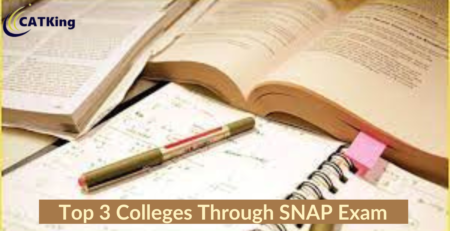Strategy for SNAP
Strategy for SNAP
What is SNAP?
The Symbiosis National Aptitude Test is a national-level test. As a result, students get admission into Symbiosis Institute of Business Management (Pune). And also its other affiliated institutes. Moreover, the test scores are valid for around 15 institutes that are associated with Symbiosis. Therefore, it makes it a pretty important exam. SNAP 2019 was a computer-based (CBT) exam. In this article let’s try to make a strategy for the SNAP exam that can help you ace it.
Join our Courses for preparation with Experts
So, the pattern/difficulty level of SNAP has been more or less uniform throughout the years. Which makes it easier to define a strategy for the same. Also, making a well-defined preparation strategy will ensure that you channel your efforts in the right direction.
SNAP Exam pattern:
Total Number of Questions: 60
Time duration: 60 minutes
Total Marks: 60 marks
Further, Section-wise Breakup of Questions:
- General English: Reading Comprehension, Verbal Reasoning, Verbal Ability: 15 Questions, 15 Marks
- Analytical & Logical Reasoning: 25 Questions, 25 Marks
- Quantitative, Data Interpretation & Data Sufficiency: 20 Questions, 20 Marks
Also check: Courses on SNAP curated by Top B-school mentors
SNAP Notification: Most importantly SNAP has removed GK Section 2019 onwards.
SNAP Preparation: Tips that will help you ace it
1. Make a list:
- Firstly, have a list of every topic, across all the subjects. After that build your strategy around this list. Moreover, make sure that you know the concept/methodology of each and every topic that you have noted down.
- Because you do not want to put in months of effort so as to eventually find out that you haven’t covered everything.
Also Read: Quick look at SNAP Exam
2. Go easy:
- Then start your preparation with whatever you find easy. Or whichever topic you already have a good understanding of.
- Lastly, practice so much so that you can solve these questions in your sleep as it will ensure that you don’t lose marks in these questions in the exams.
And when you are done with these topics then you can proceed with the difficult/complex topics to build your proficiency in them.
3. Quantitative, Data Interpretation & Data Sufficiency:
- Practice Arithmetic problems extensively and gain good speed and accuracy in the same. Moreover, arithmetic topics include Time & Work, Time Speed Distance, Ratio & Proportion, Profit & Loss, etc.
- After that another topic, to focus on, is Algebra, so make sure that you are through with all the different types and difficult questions in these two topics.
- Geometry (majorly Mensuration) also appears regularly in this section.
- Data Interpretation questions will demand approximations and without approximations, you might have to spend a lot of time on calculations, which would be counter-productive.
- Therefore, sharpen your mental mathematics and approximation techniques. As the difficulty level of the DI, questions is fairly easy
Also refer: How to save time in quants and DI, DS
Further, data Sufficiency questions can sometimes be absent in this section, as has been observed in some of the previous years’ papers.
Solve at least 1 case of DI and some quantitative questions, every day
Keep revising important formulae every day
Focus on building strong Concepts and proper practice
4. Analytical & Logical Reasoning:
- So, this is the section that carries maximum weight-age in the test. Also the section which is the most scoring, as compared to the others. Moreover, this section contains a mixture of different topics.
- Further, practice questions on Blood Relations, Series, Coding-Decoding, different types of Arrangement questions, Critical Reasoning, Deduction and analogies, Visual Reasoning, Puzzles, and logical Case-lets.
As mentioned earlier, do not leave any topic, while preparing.
Practice Intensively for this section
5. English Usage:
Reading comprehension tricks necessary to crack Verbal Section
- This section is fairly easy so to crack this section, your grammar skills should be up to the mark. So make sure that you are well familiar with the rules and shortcuts in solving grammar questions. Most importantly, scoring good in grammar will increase your scores tremendously.
- Reading Comprehension questions are manageable and aren’t time-consuming. Also, the passages are usually short and not lengthy.
- Be thorough about your vocabulary. English questions are pretty easy. But can have extremely close options. Therefore, a good vocabulary is essential.
Solve 4-5 questions on correct/incorrect sentences, phrases, word usage, every day.
6. General Awareness and Static GK: There was no GK Section in SNAP Exam 2020 and 2021
7. Mocks & Previous years’ papers:
- Solve all the mocks and previous years’ papers that you get your hands on. This will give you an idea about how questions are asked in the actual papers. It will also help you get accustomed to the difficulty level of the test.
- Analyze your strengths and weaknesses after every mock test. Keep a track of your speed and accuracy for every question. This will help you in your preparation for the final day.
Most importantly remember, SNAP requires a good combination of speed and accuracy. It is therefore essential that your preparation focuses on improving both speed and accuracy, simultaneously.
SNAP Reservation Criteria
| Scheduled Tribes | 7.5% |
| Scheduled Caste | 15% |
| Differently Abled | 3% |
| Kashmiri Migrants | 2 seats per program |
| International Candidates | 15% |
SNAP Syllabus:
4 major topics to crack the Verbal section
Section 1: General English/Language skills
- Reading Comprehension
- Vocabulary
- Antonyms and Synonyms
- Sentence Correction
- Fill in the Blanks
- Critical Reasoning
- Analogy
- Proverbs & Idioms
- Para Jumbles
Section 2: Analytical & Logical Reasoning
- Visual Reasoning
- Blood Relations
- Coding/Decoding
- Syllogisms
- Analogy
- Series
- Direction-Based Questions
- Clocks
- Calendars
- Seating Arrangements
- Miscellaneous Problems
Section 3: Quantitative, Data Interpretation & Data Sufficiency
- Percentages
- Profit & Loss
- SI & CI
- Time, Speed and Distance
- Time & Work
- Mixture & Allegations
- Averages
- Ratio & Proportion
- Number System
- Geometry
- Mensuration
- Trigonometry
- Coordinate Geometry
- Permutation & Combination
- Inequalities
- Logarithmic
- Binomial Expression
- Probability
- Set Theory
- Functions
- Progressions
- Linear Equations
- Quadratic Equations
Also refer SNAP Previous year Papers
Data Interpretation:
- Pie Chart
- Bar Graph
- Line Graph
- Compound Graph
- Tables
- Caselets
- Miscellaneous
Colleges that accept SNAP score (15 participating colleges)
Also follow the MBA Exam calendar to reach the goal
- (SIBM) Symbiosis Institute of Business Management, Pune
- (SCMHRD) Symbiosis Centre for Management and Human Resource Development, Pune
- (SIIB) Symbiosis Institute of International Business, Pune
- (SIBM) Symbiosis Institute of Business Management, Bangalore
- (SIOM) Symbiosis Institute of Operations Management, Nashik
- (SITM) Symbiosis Institute of Telecom Management, Pune
- (SIMC) Symbiosis Institute of Media & Communication, Pune
- (SIHS) Symbiosis Institute of Health Sciences, Pune
- (SSBF) Symbiosis School of Banking and Finance, Pune
- (SIBM) Symbiosis Institute of Business Management, Hyderabad
- (SSSS) Symbiosis School of Sports Sciences, Pune
- (SSMC) Symbiosis School for Media & Communication, Bangalore
- (SCIT) Symbiosis Centre for Information Technology, Pune
- (SIMS) Symbiosis Institute of Management Studies, Pune
- (SICSR) Symbiosis Institute of Computer Studies & Research, Pune
Also read: Best MBA Colleges in Mumbai
Best of the above colleges mentioned through SNAP
- (SIBM) Symbiosis Institute of Business Management, Pune
- (SCMHRD) Symbiosis Centre for Management and Human Resource Development, Pune
Further more about SCMHRD
So the MBA program at SCMHRD is a standout amongst the most esteemed programs in India. Also, SCMHRD represents considerable authority in delivering quality ability. That is in the fields of HR, Marketing, and Business Analytics.
Courses offered
- Master Of Business Administration (MBA)
- MBA Executive
- PG-Diploma
College Events
Also check out more about Symbiosis Institute.
- NEEV, SCMHRD’s annual B-school festival, is the 3rd largest of its kind, in the country. Meanwhile, NEEV which is in December attracts participation from more than 15000 students from the top 40 B-schools across the country. And it is an amalgamation of various business and cultural events.
About SIBM Pune
Symbiosis Institute of Business Management, Pune is a premier B-School of India. Most importantly, perceived for its magnificence in scholastic’s. Its’ superb administration program, and profitable commitments to industry, society, as well as students. SIBM Pune was built up in 1978.
Courses offered
- MBA
- Executive MBA Programme
- Post Graduate Diploma Programmes
Above all, the MBA programs offered by Symbiosis are unique. And what makes it is that they are specialized in different sectors and industries. Therefore, make sure that you follow the above-mentioned guidelines and crack the test!
Other than Symbiosis universities
- NIA Business School – Noida
- Badruka Institute of Foreign Trade (BIFT), Hyderabad
- Balaji Institute of Telecom & Management (BITM), Pune
- Management Institute for Leadership and Excellence – MILE, Pune
- MIT COM, Pune
- Lotus Business School, Pune
- Indian Institute of Management Training (IIMT), Pune
- Suryadatta Institute of Management & Mass Communication, Pune
- Lakshmi Narain College of Technology, Bhopal (LNCT-B), Bhopal.
Thank you for reading this article on the SNAP strategy. And I hope this helps you prepare better for your exam.
All the best!














